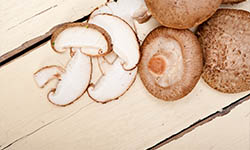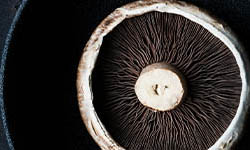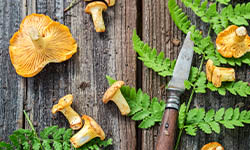The Magic of Mushrooms
The advantages of incorporating mushrooms into your diet include their rich nutritional profile, potential immune-boosting properties, and versatility in various culinary dishes. Of the approximately 14,000 species of mushrooms on the planet, many make delicious additions to soups, salads, sauces, stir-fries, casseroles, and plant-based burgers. They’re the only veggie source of vitamin D (and one of the few foods that naturally contain this micronutrient). They’re also low in fat and carbohydrates and provide significant amounts of vitamins A, C, B6, and B12 and selenium.
Here’s a list of 10 mushrooms that are worth a spot on your plate:

1. White button: It’s no surprise that this mushroom is one of the most popular. Petite and mild, they bring chunky texture and a hint of earthy flavor to just about any meal. One serving of five medium white button mushrooms contains 20 calories, 0 g fat, 3 g carbs, and 3 g protein.

2. Cremini: Aside from colour, cremini mushrooms (also spelled “crimini”) are similar in appearance to white buttons, but they come with a deeper, more potent flavor. One serving of four cremini mushrooms contains 18 calories, 0 g fat, 3 g carbs, and 2 g protein.

3. Shiitake: These East Asian natives have broad brown caps and curved stems, are high in fiber, and have antioxidant benefits. In recipes, shiitakes contribute meaty texture and earthy taste. The stems are tough to eat, so be sure to remove them and save to make a savory broth. One serving of four shiitake mushrooms contains 26 calories, 0 g fat, 5 g carbs, and 2 g protein.

4. Maitake: Also known as ‘hen of the woods’, or ‘sheep’s head’, they grow in unique clusters that resemble the petals of a flower. Their taste can be described as peppery, woodsy, or spicy. A 1-cup serving of maitake mushrooms contains 22 calories, 0 g fat, 5 g carbs, and 1 g protein.

5. Oyster: First cultivated to stave off starvation in post-World War I Germany, they have since blossomed into a sought-after culinary treat all over the globe. Their rippled, fan-like caps resemble the flared body of an oyster. It is preferable to cook 0yster mushrooms as they can have a slightly metallic taste when eaten raw. One serving of six small oyster mushrooms contains 30 calories, 0 g fat, 5 g carbs, and 3 g protein.

6. Enoki: Narrow and pencil-thin, with long stalks and itty-bitty heads, Enoki are known for their delicate flavor and take on any flavor you apply. Crunchy when raw and tender when cooked, they’re versatile in broth bowls, stir-fries, and soups. One serving of 17 large enoki mushrooms contains 31 calories, 0 g fat, 7 g carbs, and 2 g protein.

7. Beech: Their small heads are typically dappled with light brown and/or white coloring, and they grow in “bouquets” of multiple stalks. They’re also found growing on the sides of beech trees — hence their name. A 57-gram serving of beech mushrooms contains 22 calories, 0 g fat, 4 g carbs, and 1 g protein.

8. Portobello: Famous for their sturdiness and caps up to 6 inches in diameter, portobellos are an ideal vegetarian burger alternative with their meaty texture and smoky flavor. One whole portobello mushroom contains 19 calories, 0 g fat, 3 g carbs, and 2 g protein.

9. Trumpet: These meaty mushrooms are often used as a vegan alternative to scallops. Also known as king oyster, king trumpet, or French horn mushrooms, they resemble a brass instrument, with a medium-long stalk and a flared head. One serving (87 g) of royal trumpet mushrooms contains 30 calories, 0 g fat, 5 g carbs, and 3 g protein.

10. Chanterelle: Also known as pfifferling, golden, yellow, or egg mushrooms, resembling seashells or flowers. Chanterelle are difficult to cultivate, which is why they are best foraged for in the wild in the Pacific northwest. Try them in a salad, omlette, or decadent risotto. One serving (100 g) of chanterelle mushrooms contains 32 calories, 0 g fat, 6.86 g carbs, and 3.8 g protein.
Wild mushrooms
If you do decide to “go wild,” you’ll find innumerable varieties at grocery stores to try. Common favourites include chanterelles, porcinis, and morels. Some of my favourites are shitake, maitake and cremini, which I try to incorporate into my weekly menus.
*Do not eat a wild mushroom unless you’re absolutely sure it’s been vetted for safety.
Enjoy my delicious and nutritious mushroom soup recipe and add all the many different kinds of mushrooms that appeal to you. This a great warming soup during the winter season! View recipe >
Resource and reference:
“Mushroom Heaven: Why These 10 Edible ’Shrooms Deserve a Spot on Your Plate”, Sarah Garone, Nutritionist for Greatist.com. Medically reviewed by Kim Rose-Francis RDN, CDCES, CNSC, LD,. April 28, 2021. Retrieved 29 January 2024.<https://greatist.com/eat/edible-mushrooms>.
Marsha Fenwick, C.N.P. R.R.T.
Marsha is not your typical nutritionist. She began her career 20 years ago as a Registered Respiratory Therapist. Later, she earned her certifications as a Registered Nutritional Consultant Practitioner, Certified Nutritional Practitioner, and Registered Orthomolecular Health Practitioner. Marsha is also a Certified Cancer Coach. Her clinical practice specializes in: sustainable healthy weight loss, digestive health, women's hormones, diabetes, heart health, and cancer prevention and recovery. For more information and to book a FREE 15 minute consultation go to www.marshafenwicknutrition.com







